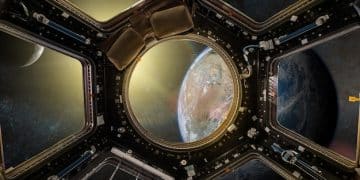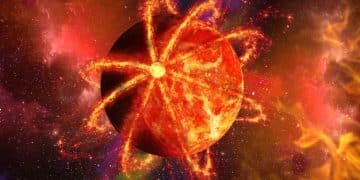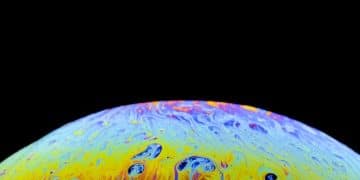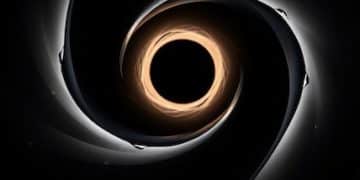Unveiling Cosmic Dust Analysis: Star & Planet Formation Secrets
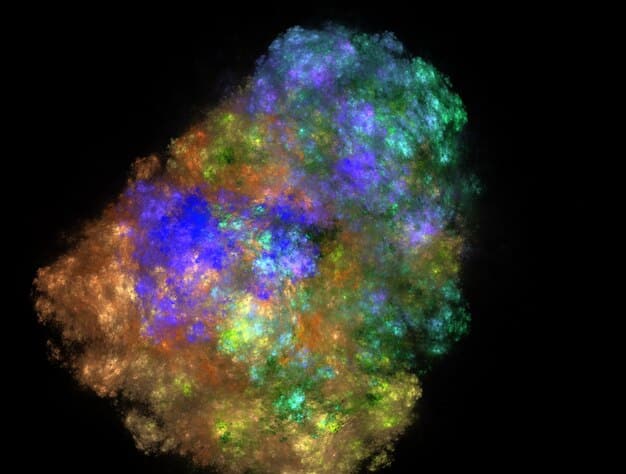
Cosmic dust analysis provides invaluable insights into the formation of stars and planets by revealing the composition, origin, and evolution of the building blocks of our universe, enhancing our understanding of cosmic evolution.
Have you ever wondered what the universe is made of, beyond the stars and galaxies we can see? The answer lies, in part, in tiny grains of cosmic dust. Understanding where it comes from is key to understanding how the universe took shape. Let’s delve into cosmic dust analysis and discover how it helps us understand the formation of stars and planets.
What is Cosmic Dust?
Cosmic dust, often referred to as stardust, is composed of tiny particles of solid matter floating in the vast expanse of space. It’s not like the household dust you find under your bed. Understanding what it really consists of starts with its composition and origin.
Composition and Origin of Cosmic Dust
Cosmic dust comprises various elements and compounds, including carbon, silicon, iron, and oxygen. These elements are fused inside stars through nuclear reactions. Understanding its composition is vital to understanding its role in shaping the universe.
- Stellar Processes: Cosmic dust is primarily formed in the late stages of stellar evolution, particularly in the outer layers of dying stars.
- Supernova Explosions: Supernovae are another significant source of cosmic dust, scattering newly formed elements across space.
- Interstellar Medium: Dust grains grow as they accumulate atoms and molecules from the interstellar medium, further evolving their composition.
Cosmic dust acts as a catalyst for molecules to form, even something as essential as water. Now let’s understand further why analyzing these tiny grains of matter matters.
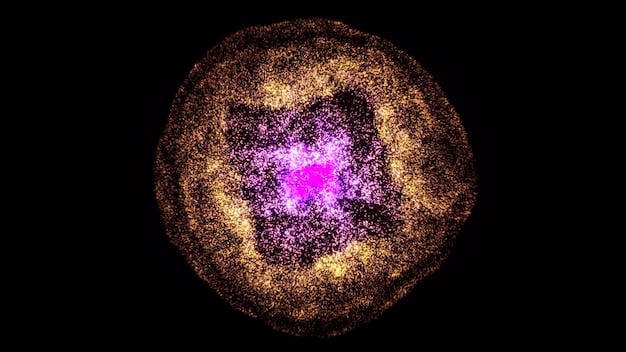
Why Analyze Cosmic Dust?
Analyzing cosmic dust is crucial because it provides fundamental insights into the processes of star and planet formation, the chemical evolution of galaxies, and the origin of life.
Insights into Star Formation
Cosmic dust plays a crucial role in the formation of stars by facilitating the collapse of molecular clouds. It helps cool these clouds and provides surfaces for molecules to form.
Understanding Planet Formation
Cosmic dust grains serve as the building blocks for planets. They collide and stick together, gradually forming larger bodies known as planetesimals, which eventually merge to become planets.
- Planetesimal Formation: Dust grains aggregate into larger clumps via electrostatic forces and collisions.
- Protoplanetary Disks: Inside protoplanetary disks, dust influences gas dynamics and facilitates planet formation.
- Chemical Composition: The composition of dust influences the chemical makeup of planets, including the presence of water and organic molecules.
Analyzing cosmic dust helps us understand how the raw materials needed for life are distributed throughout the cosmos.
Techniques for Cosmic Dust Analysis
Various sophisticated scientific techniques are employed to analyze cosmic dust, each providing unique insights into its composition and structure. These methods include sophisticated spectrometry for composition analysis and advanced microscopy to probe the structure of individual grains.
Spectrometry
Spectrometry is a technique used to identify the chemical elements and compounds present in cosmic dust by analyzing the light they emit or absorb. It requires the light to be separated into its component wavelengths, creating a spectrum.
Microscopy and Imaging
Microscopy techniques, such as scanning electron microscopy (SEM) and transmission electron microscopy (TEM), are used to image cosmic dust grains at high magnification. It allows scientists to visualize the shape, size, and surface texture of individual dust particles.
- Scanning Electron Microscopy (SEM): Provides high-resolution surface images of dust grains.
- Transmission Electron Microscopy (TEM): Used to examine the internal structure and composition of dust particles.
- Atomic Force Microscopy (AFM): Measures surface topography at the atomic level, revealing details about mineral structures.
These advanced methods need to be used in conjunction to reveal different properties of the dust particles.
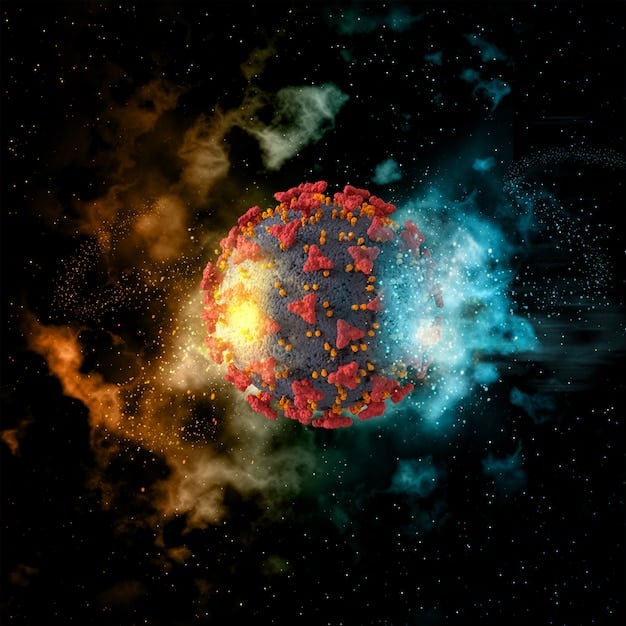
What Can We Learn About Stars?
Cosmic dust analysis provides crucial insights into the life cycle of stars, from their birth in molecular clouds to their explosive deaths as supernovae. Dust composition reflects the environment and processes within stars.
Stellar Evolution
The composition of cosmic dust can reveal the elements synthesized within stars and ejected into space during their late stages, providing clues about stellar nucleosynthesis.
Supernova Remnants
Analyzing dust in supernova remnants helps us understand the conditions and processes during these explosive events, enriching our knowledge of extreme astrophysical phenomena.
In detail, stardust can carry isotopes that directly tell us about the types of nuclear reactions ongoing within stars.
Planets and Cosmic Dust Connection
Cosmic dust plays a pivotal role in the formation of planets by acting as a seed material in protoplanetary disks. Further, chemical compositions in planets depend on the original dust composition.
Protoplanetary Disks Composition
Dust is abundant in these disks, where it provides the raw material for planet formation. The composition and distribution of dust within these disks influence the types of planets that can form.
- Dust Rings and Gaps: These structures indicate ongoing planet formation processes.
- Ice Lines: Dust composition changes with distance from the star, influencing where gas giants and rocky planets form.
- Organic Molecules: The presence of organic molecules in dust hints at the potential for life-bearing planets.
Insights into Earth’s Formation
Studying cosmic dust provides clues about the origin of water and organic molecules on Earth. It facilitates the understanding of the conditions that led to the emergence of life.
Dust analysis helps us understand how planetary systems end up with conditions suitable for life.
Future Directions in Cosmic Dust Analysis
The future of cosmic dust analysis involves advanced missions and techniques that promise to revolutionize our understanding of the cosmos. In particular, new tools are being developed that can analyze smaller samples with greater sensitivity.
Advanced Missions
Future space missions will collect and analyze cosmic dust samples with unprecedented precision, providing valuable insights into the origins of stars, planets, and life. What is more, sample return missions would be even better.
Laboratory Analysis
Ongoing laboratory experiments aim to simulate the conditions in space and study the formation and evolution of cosmic dust under controlled environments.
- Improved Spectrometers: Developing more sensitive and higher-resolution spectrometers.
- Advanced Microscopy: Using techniques like cryo-TEM to preserve fragile dust structures.
- Computational Modeling: Combining observational data with theoretical models to simulate dust formation and evolution.
More data would not only confirm existing theories but also lead to new theoretical developments. Combined with these developments, dust analysis may soon become one of the most important sources of new discoveries.
| Key Point | Brief Description |
|---|---|
| 🔭 Dust Origin | From stellar processes and supernova, dust brings important elements. |
| ✨ Star Formation | Dust facilitates molecular cloud collapse, aiding star birth. |
| 🪐 Planet Building | Planets arise from cosmic dust aggregation in protoplanetary disks. |
| 🔬 Analysis Tools | Techniques like spectrometry, SEM, TEM reveal dust composition. |
What are the primary sources of cosmic dust?
▼
Cosmic dust mainly originates from the late stages of stellar evolution and supernova explosions, where elements synthesized within stars are ejected into space.
▼
Cosmic dust serves as the building blocks for planets by colliding and sticking together in protoplanetary disks.
▼
Spectrometry and microscopy techniques, such as SEM and TEM, are commonly used to analyze the chemical composition and structure of cosmic dust particles.
▼
The composition of cosmic dust reveals elements synthesized within stars, providing clues about stellar nucleosynthesis and evolutionary processes.
▼
Future space missions aim to collect and analyze cosmic dust samples with unprecedented precision, offering deeper insights into cosmic origins.
Conclusion
Cosmic dust analysis offers a unique window into the universe’s past, present, and future. By studying these tiny particles, scientists can unlock the secrets of star and planet formation and gain a deeper understanding of our cosmic origins. The journey of discovery continues with advanced missions and techniques promising even more groundbreaking insights in the years to come.
